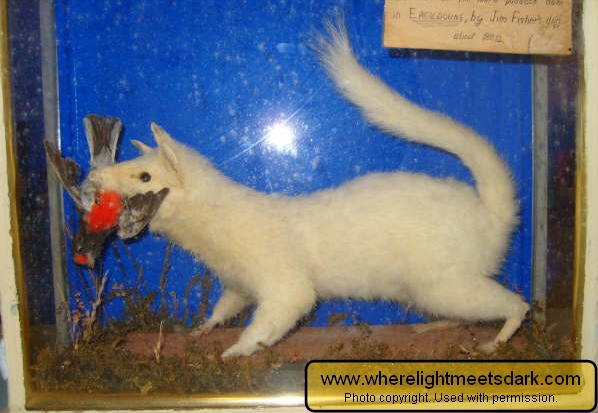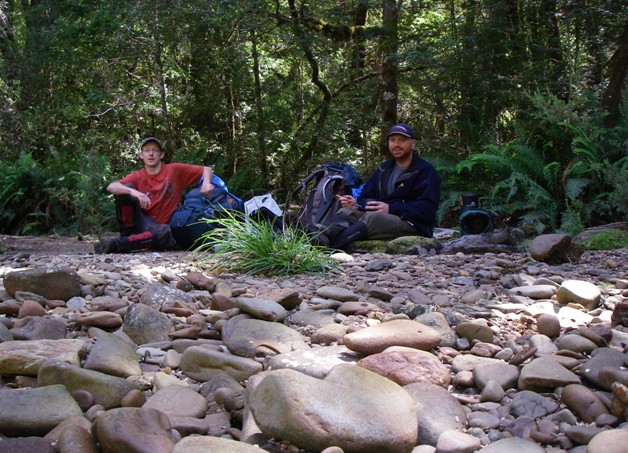
May 13, 2009
Chris Rehberg (above) at the website Where Light Meets Dark has confirmed that the new “MonsterQuest” episode “Isle of the Lost Tiger,” will screen this week, and shall feature the WLMD Expedition in search of the Thylacine or Tasmanian Tiger (Thylacinus cynocephalus) carried out in 2009.
Screening dates in the US are Wednesday, May 13, 2009 (9 pm Eastern), Thursday, May 14 (1 am E) and Sunday May 24 (9 am E). Check your local listings for times in your area. Image: WLMD

Dr. Jeremy Austin and a juvenile thylacine from the University of Adelaide.
The WLMD site gives a summary on the “Tasmanian Tiger Expedition2009.”
The almost final results achieved are listed as the following:
Even though the final trek of the expedition has not yet been undertaken, a number of positive outcomes have been achieved already.
A previously unknown Tasmanian wedge-tailed eagle nest was discovered. There are believed to be only about 200 nesting sites remaining in Tasmania.
The elusive ground parrot was identified by its call. Coincidentally, I only recognised the call because of last year having examined evidence for its survival in Sydney where it has not been sighted in over 100 years.

Above: Where Light Meets Dark recently published a photograph of an all-white Eastern quoll taxidermy, prepared in 1882. The quoll was captured in Ercildoune, Victoria and since publishing these photos the Australian Museum has confirmed that it too has an all-white specimen, also from the mainland. Photo used by permission.
The program will have the final discoveries and scientific analyses of those.

Here is the description of the episode, “Isle of the Lost Tiger”:
A remote island off the coast of Australia was once home to a real monster with vampire-like tendencies. The Tasmanian Tiger, which was known for its massive jaws and sharp incisors, stalked livestock and terrified the human inhabitants of the island before a bounty brought about the Tiger’s extinction almost eighty years ago. But if the eyewitness stories and scientific breakthroughs are correct, this creature may be on the verge of making a comeback. Across Tasmania there have been over 350 sightings of this monster, including reports from experienced biologists and outdoorsmen. Meanwhile, in an Australian laboratory, one scientist is using a preserved strand of DNA in an attempt to resurrect the tiger. Now, the MonsterQuest science and expedition teams will seek to find the ultimate proof that the Tasmanian Tiger could be alive and stalking the subtropical forests of this distant island.
About Loren Coleman
Loren Coleman is one of the world’s leading cryptozoologists, some say “the” leading living cryptozoologist. Certainly, he is acknowledged as the current living American researcher and writer who has most popularized cryptozoology in the late 20th and early 21st centuries.
Starting his fieldwork and investigations in 1960, after traveling and trekking extensively in pursuit of cryptozoological mysteries, Coleman began writing to share his experiences in 1969. An honorary member of Ivan T. Sanderson’s Society for the Investigation of the Unexplained in the 1970s, Coleman has been bestowed with similar honorary memberships of the North Idaho College Cryptozoology Club in 1983, and in subsequent years, that of the British Columbia Scientific Cryptozoology Club, CryptoSafari International, and other international organizations. He was also a Life Member and Benefactor of the International Society of Cryptozoology (now-defunct).
Loren Coleman’s daily blog, as a member of the Cryptomundo Team, served as an ongoing avenue of communication for the ever-growing body of cryptozoo news from 2005 through 2013. He returned as an infrequent contributor beginning Halloween week of 2015.
Coleman is the founder in 2003, and current director of the International Cryptozoology Museum in Portland, Maine.
Filed under Breaking News, Cryptotourism, CryptoZoo News, Cryptozoologists, Cryptozoology, Expedition Reports, Men in Cryptozoology, Thylacine